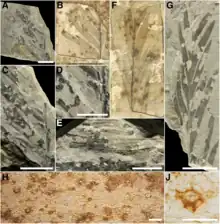| Almargemia Temporal range: | |
|---|---|
 | |
| Scientific classification | |
| Kingdom: | Plantae |
| Clade: | Tracheophytes |
| Clade: | Gymnospermae |
| Division: | Cycadophyta |
| Class: | Cycadopsida |
| Order: | Cycadales |
| Family: | Zamiaceae |
| Genus: | †Almargemia Florin 1933[1] |
| Species | |
| |
Almargemia is a genus of fossil leaves from the Early Cretaceous of Portugal produced by members of the Zamiaceae. It was erected by Rudolf Florin based on macrofossil material with preserved cuticle.[2]
Taxonomy
The material on which it is based was first described by Oswald Heer under the name Ctenidium dentatum and C. integerrimum.[3] Later, the cuticle was described by Florin, who transferred the material to the newly erected genus Almargemia.
Description
The leaflets of Almargemia have few parallel veins that do not fuse together. The leaflet margin have large, lobe-like teeth. The cuticle has elongated pavement cells, with some pavement cells having a dark-stained cuticles. The stomata are sunken in a stomatal pit.
References
- ↑ Florin, Carl Rudolf (1933). Studien uber die Cycadales des Mesozoikums nebst Erorterngen uber die Spaltoffnungsapparate der Bennettitales. K. Svenska Vetensk. Acad. Handl.
- ↑ Florin, Carl Rudolf (1933). Studien uber die Cycadales des Mesozoikums nebst Erorterngen uber die Spaltoffnungsapparate der Bennettitales. K. Svenska Vetensk. Acad. Handl.
- ↑ Heer, Oswald (1881). Contributions à la flore fossile du Portugal. J. Wurster.
This article is issued from Wikipedia. The text is licensed under Creative Commons - Attribution - Sharealike. Additional terms may apply for the media files.